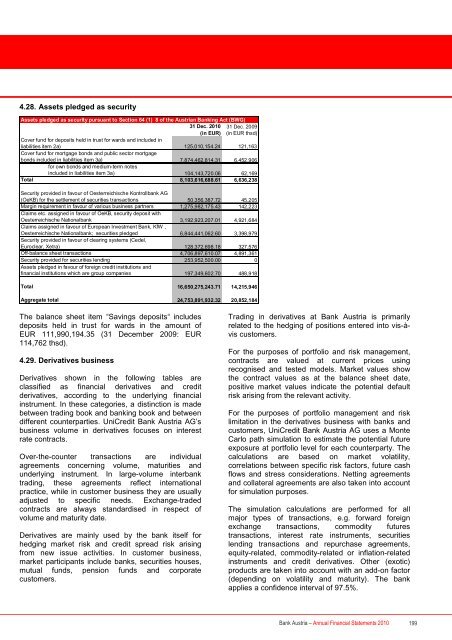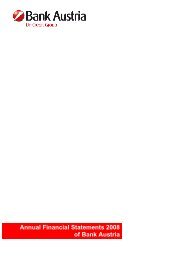Annual Financial Statements 2010 of Bank Austria
Annual Financial Statements 2010 of Bank Austria
Annual Financial Statements 2010 of Bank Austria
Create successful ePaper yourself
Turn your PDF publications into a flip-book with our unique Google optimized e-Paper software.
Notes to the <strong>Financial</strong> <strong>Statements</strong><br />
4.28. Assets pledged as security<br />
Assets pledged as security pursuant to Section 64 (1) 8 <strong>of</strong> the <strong>Austria</strong>n <strong>Bank</strong>ing Act (BWG)<br />
31 Dec. <strong>2010</strong> 31 Dec. 2009<br />
(in EUR) (in EUR thsd)<br />
Cover fund for deposits held in trust for wards and included in<br />
liabilities item 2a) 125,010,154.24 121,163<br />
Cover fund for mortgage bonds and public sector mortgage<br />
bonds included in liabilities item 3a) 7,874,462,814.31 6,452,906<br />
for own bonds and medium-term notes<br />
included in liabilities item 3a) 104,143,720.06 62,169<br />
Total 8,103,616,688.61 6,636,238<br />
Security provided in favour <strong>of</strong> Oesterreichische Kontrollbank AG<br />
(OeKB) for the settlement <strong>of</strong> securities transactions 50,356,387.72 45,205<br />
Margin requirement in favour <strong>of</strong> various business partners 1,275,982,175.43 142,223<br />
Claims etc. assigned in favour <strong>of</strong> OeKB, security deposit with<br />
Oesterreichische Nationalbank 3,192,923,207.01 4,921,684<br />
Claims assigned in favour <strong>of</strong> European Investment <strong>Bank</strong>, KfW ,<br />
Oesterreichische Nationalbank; securities pledged 6,844,441,062.60 3,398,979<br />
Security provided in favour <strong>of</strong> clearing systems (Cedel,<br />
Euroclear, Xetra) 128,372,698.18 327,576<br />
Off-balance sheet transactions 4,706,897,610.07 4,891,361<br />
Security provided for securities lending 253,952,500.00 0<br />
Assets pledged in favour <strong>of</strong> foreign credit institutions and<br />
financial institutions which are group companies 197,349,602.70 488,918<br />
Total 16,650,275,243.71 14,215,946<br />
Aggregate total 24,753,891,932.32 20,852,184<br />
The balance sheet item “Savings deposits“ includes<br />
deposits held in trust for wards in the amount <strong>of</strong><br />
EUR 111,990,194.35 (31 December 2009: EUR<br />
114,762 thsd).<br />
4.29. Derivatives business<br />
Derivatives shown in the following tables are<br />
classified as financial derivatives and credit<br />
derivatives, according to the underlying financial<br />
instrument. In these categories, a distinction is made<br />
between trading book and banking book and between<br />
different counterparties. UniCredit <strong>Bank</strong> <strong>Austria</strong> AG’s<br />
business volume in derivatives focuses on interest<br />
rate contracts.<br />
Over-the-counter transactions are individual<br />
agreements concerning volume, maturities and<br />
underlying instrument. In large-volume interbank<br />
trading, these agreements reflect international<br />
practice, while in customer business they are usually<br />
adjusted to specific needs. Exchange-traded<br />
contracts are always standardised in respect <strong>of</strong><br />
volume and maturity date.<br />
Derivatives are mainly used by the bank itself for<br />
hedging market risk and credit spread risk arising<br />
from new issue activities. In customer business,<br />
market participants include banks, securities houses,<br />
mutual funds, pension funds and corporate<br />
customers.<br />
Trading in derivatives at <strong>Bank</strong> <strong>Austria</strong> is primarily<br />
related to the hedging <strong>of</strong> positions entered into vis-àvis<br />
customers.<br />
For the purposes <strong>of</strong> portfolio and risk management,<br />
contracts are valued at current prices using<br />
recognised and tested models. Market values show<br />
the contract values as at the balance sheet date,<br />
positive market values indicate the potential default<br />
risk arising from the relevant activity.<br />
For the purposes <strong>of</strong> portfolio management and risk<br />
limitation in the derivatives business with banks and<br />
customers, UniCredit <strong>Bank</strong> <strong>Austria</strong> AG uses a Monte<br />
Carlo path simulation to estimate the potential future<br />
exposure at portfolio level for each counterparty. The<br />
calculations are based on market volatility,<br />
correlations between specific risk factors, future cash<br />
flows and stress considerations. Netting agreements<br />
and collateral agreements are also taken into account<br />
for simulation purposes.<br />
The simulation calculations are performed for all<br />
major types <strong>of</strong> transactions, e.g. forward foreign<br />
exchange transactions, commodity futures<br />
transactions, interest rate instruments, securities<br />
lending transactions and repurchase agreements,<br />
equity-related, commodity-related or inflation-related<br />
instruments and credit derivatives. Other (exotic)<br />
products are taken into account with an add-on factor<br />
(depending on volatility and maturity). The bank<br />
applies a confidence interval <strong>of</strong> 97.5%.<br />
<strong>Bank</strong> <strong>Austria</strong> – <strong>Annual</strong> <strong>Financial</strong> <strong>Statements</strong> <strong>2010</strong> 199
















